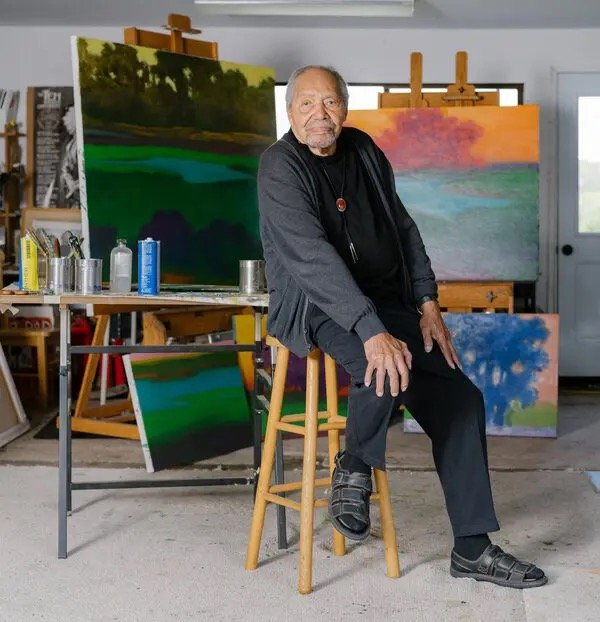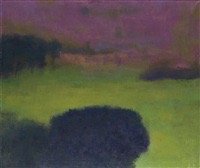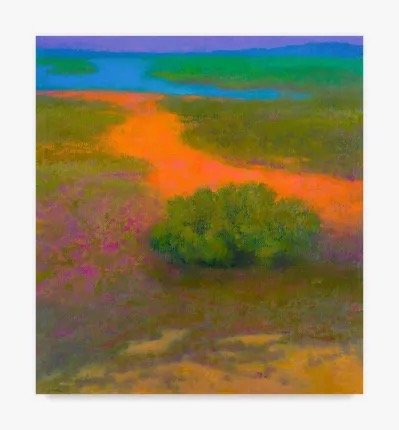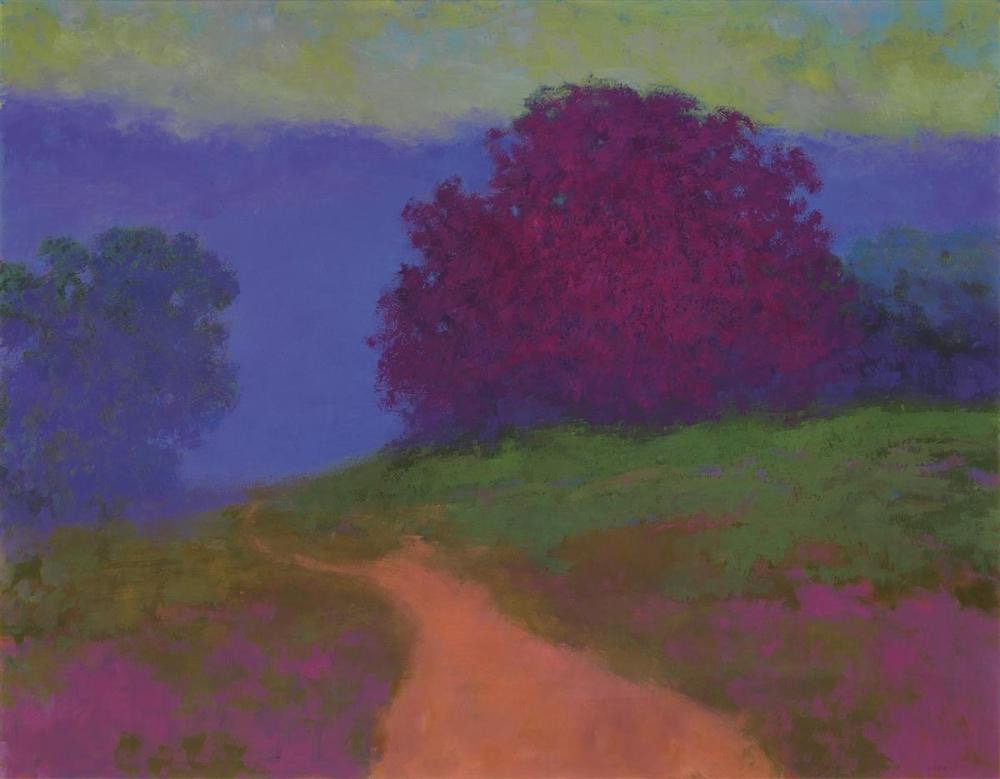Artist to Know: Richard Mayhew - Spiritual Landscapes
I am a really big fan of landscapes. I love to paint them and I love artists who paint them especially artists who capture the delicate and beautiful emotional aspect of viewing natural scapes rather than just showing realistic trees and fields.
Richard Mayhew (1924-2024) is an African and Native American artist and teacher whose work evokes the mysterious and mystical aspects of the natural world through his signature landscapes.
Artist Richard Mayhew in his California studio in May 2023.
His work uses diffused color blocks and forms to reveal an evocative and emotion-filled view of the natural world and he is considered "one of America's most important landscape artists” (https://www.culturetype.com/2024/04/03/richard-mayhew-at-100-artistic-community-pays-tribute-to-one-of-americas-most-important-landscape-painters/).
Images: Tree Study, (1960) Ink on laid paper, 13.5 x 12.25 in. (34.3 x 31.1 cm.); Nyack (1975) oil on canvas, 40 × 46 in. (101.6 × 116.8 cm), Collection SFMOMA, Gift of the Joyner/Giuffrida Collection, https://www.sfmoma.org/artwork/2020.105; Iroquois Spring (1975) oil on canvas, 59.75 x 84 in. (151.8 x 213.4 cm; Briarwood (1982) oil on canvas, 42 1/8 x 37 3/4 in. (107 x 95.9 cm); Serenade (1964-66) oil on linen canvas, circa 1964-66. 1219x914 mm; 48x36 inches; Eclipse (1965) oil on linen canvas, 762x1016 mm; 34x40 inches; Untitled (Clam Diggers) (1970-1975) oil on linen canvas, 610x1016 mm; 24x40 inches; Chippewa (1974) oil on linen canvas, 86.4 x 9.5 cm. (34 x 3.7 in.).
Mayhew grew up in Amityville, NY He was an enrolled-citizen of the Montaukett Indian Nation and learned from his grandmother to have a reverence for nature. Mayhew decided by age 17 that he wanted to be an artist.
He studied at Art Students League of New York and with artist Edwin Dickinson and later attended Brooklyn Museum Art School 1948 to 1959 studying with Reuben Tam. He graduated from Columbia University with a degree in art history.
To make ends meet, Mayhew decorated china in the 1940s. In the 1950s, Mayhew performed as a jazz singer at clubs in New York and at resorts in the Catskills but in 1955 with his first solo exhibition in Brooklyn, he cut short his singing career to devote himself to painting.
During the 1960s he illustrated children's books while he developed his painting style. During this period, Mayhew was a founding member of the art collective Spiral which included artists like Romare Bearden and Charles White formed after the March on Washington in 1963 as a way for artists to explore issues surrounding the Civil Rights Movement.
Mayhew taught art and interdisciplinary studies at various schools between 1963 and 1992 including Brooklyn Museum Art School (1963), Pratt Institute (1963), Art Students League of New York (1965), Smith College (1969), Hunter College (1971), California State University, East Bay (1974), San Jose State University (1975), Sonoma State University (1976), University of California, Santa Cruz (1992) and taught at Penn State University for 13 years (1977-1991)
Images: Beyond the Bramble Bush (1996–97) oil on canvas, 48 x 44 in., Artist’s estate and Venus Over Manhattan; Guardian (1999) oil on canvas, 48 1/4 x 40 in. (122.6 x 101.6 cm); Transfiguration (1999) oil on canvas 50 x 60 in.; Spiritual Path (1998), oil on canvas, 914x1219 mm.
Mayhew challenged the conventional purpose of American landscape paintings as a way to survey land that would eventually be annexed and confiscated from the native people who already inhabited it by creating landscapes that placed the viewer at ground level rather than at a higher vista as was common for the 19th century Hudson River School movement, and rather than see the landscape as a land to be conquered and tamed, captured the spiritual essence of the natural world.
Images: Red Bush (1990s) oil on canvas, Museum of the African Diaspora; Rhapsody (2002) oil on canvas, 48 x 60 in. (121.9 x 152.4 cm), San Francisco, California, M.H. de Young Museum Collection.
Mayhew’s work, at first glance looks to be beautifully crafted bucollic landscapes with a dreamy, hazy hue, but in each of his paintings there is a deeper message about social injustice, civil rights, oppression and denial which were integral pieces of his long life.
“I’m painting Forty Acres and a Mule. I’m painting the treaty land that was never honored for Native Americans.”
Mayhew's amazing works are in the permanent collections of San Francisco Museum of Modern Art (SFMoMA), De Young (museum), Metropolitan Museum of Art, Whitney Museum of American Art, and the Smithsonian Institution, among others. He died at the age of 100 on September 26, 2024 in Soquel, CA.
Images: Delusions (2000) oil on canvas, 30 × 40 in. (76.2 × 101.6 cm), Gift of The Pamela J. Joyner and Alfred J. Giuffrida Collection; Departure (2006) oil on linen canvas, 48x60 in. (1219x1524 mm) ; Pescadero (2014) oil on canvas, Town of Huntington Art Acquisition Fund; Pamela’s Aura (2004) COURTESY THE ARTIST’S ESTATE AND VENUS OVER MANHATTAN; Crescendo (2008) COURTESY THE ARTIST’S ESTATE AND VENUS OVER MANHATTAN; Atascadero (2012-2013) silkscreen, 30 × 40 in (76.2 × 101.6 cm); April Series #2 (2022) watercolor, 11 × 15 in. (27.9 × 38.1 cm); Misty Mystic (2012) Oil on canvas 30 x 40 in. 76.2 x 101.6 cm.
Richard Mayhew’s long career demonstrated the evolution of a modern vision of how emotion and mystery can be imbedded in a traditional genre like landscape art. The beauty and power of his juxtaposed hues including pinks, oranges, yellows and blues transformed his landscapes into stunning windows into a magical world.























